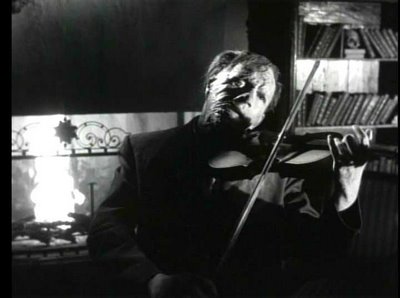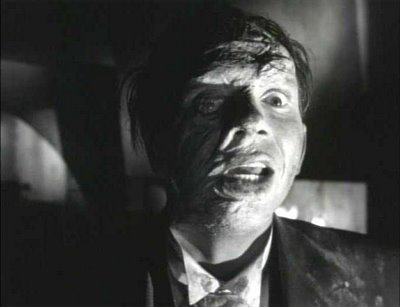I've sometimes wondered what it must be like, for someone who once had the privilege of seeing LONDON AFTER MIDNIGHT, to know that their own memory of this 1928 Lon Chaney classic may be all that survives of it. Now I have my answer -- because I have a precious childhood memory of being enthralled by a 1964-65 local television broadcast of a 1959 Mexican horror movie entitled BLACK PIT OF DR. M.
I saw the film on Cincinnati's WCPO-TV, then the city's CBS affiliate, and they had a strange habit in those days of starting movies in progress, fading in at some point after the opening credits. These would them be paraphrased by a single transparent overlay that read, for example, "BLACK PIT OF DR. M, starring Rafael Bertrand & Mapita Cortes." (This is also the way I saw James Whale's FRANKENSTEIN for the very first time.) I mention all this because, evidently, the English soundtrack for BLACK PIT OF DR. M has been missing-in-action for many years and will likely never heard again. Yet I remember seeing that film in English, minus its main titles, and being very impressed by it, one of those wondrous encounters with a movie on television that happens once and never again.
Since that initial viewing, I've been able to see BLACK PIT OF DR. M once in Spanish under its original title MISTERIOS DE ULTRATUMBA ("Mysteries from Beyond the Grave") and again this past weekend via an advance copy of Casa Negra Entertainment's DVD of BLACK PIT OF DR. M. The disc streets tomorrow, August 29, along with their eagerly awaited DVD of Chano Urueta's mind-boggling THE BRAINIAC [EL BARON DEL TERROR, 1962].
Directed by Fernando Mendez -- among the most accomplished of all Mexican horror specialists, whose work includes the Nostradamus series, the diptych THE VAMPIRE and THE VAMPIRE'S COFFIN, and the KILL, BABY... KILL!-like La Llorona Western THE LIVING COFFIN -- BLACK PIT OF DR. M chronicles the devastating aftermath of a metaphysical agreement between two doctors. In a page taken from Edgar Allan Poe's "The Case of M. Valdemar," Dr. Masali, director of the Mercedes Asylum, reminds his dying associate Dr. Jacinto Aldama of his promise to somehow retrieve for him the secret of how one might pass into the Beyond and return with its secrets to the realm of the living. When Aldama dies, he speaks to Masali through a medium and reveals that their plan is feasible. He foretells that, on a specific day and hour, two weeks hence, a door will close -- and its closure will portend the opening of a series of doors leading Masali to the horror of what he wishes to know.
The script by Ramón Obón (who later directed the K. Gordon Murray import 100 CRIES OF TERROR, 1965) boasts an unusual degree of delicacy and ambition, and these qualities are superbly complemented by the monochromatic photography of Victor Herrera, whose John Alton-inspired use of hard whites and blacks anticipates the look of Mario Bava's subsequent BLACK SUNDAY [LA MASCHERA DEL DEMONIO, 1960].

The burial of Dr. Aldama.
Bava had conjured his own unique horror atmosphere a year earlier in I VAMPIRI, but there is enough in BLACK PIT OF DR. M to make one wonder if he might have seen it prior to making BLACK SUNDAY. The scene of Elmer (Carlos Ancira, an asylum attendant disfigured with acid) bare-handedly clawing his way out of his grave and stomping off through the misty graveyard looks ahead to how Bava staged the resurrection of Javutich, and both films feature scenes in which metaphysical forces cause things to happen by affecting the wind. Both movies also end with a last-minute attempt by the monster to destroy the heroine's beauty, and with a fist-fight between the monster and the romantic male lead (in this case, Gaston Santos -- a young Mexican actor who somewhat resembles BLACK SUNDAY star John Richardson). A haunting scene of the misshapen Elmer calling attention to himself by playing a violin is also closer than anything else found in the cinema to a character Bava once described as a recurring figure in his nightmares -- a corpse who serenades his beloved by playing a violin bow across the exposed nerves of his decaying forearm.

Casa Negra presents BLACK PIT OF DR. M with its original Spanish soundtrack and English subtitles -- a step forward from the unsubtitled VHS in circulation, as is the handsome 1.33 windowboxed audio/visual presentation. Though naturally lacking the lost English dub track, the disc goes the extra mile in this direction by providing the original English continuity script, which allows us to read how the film was originally dubbed. But, in one of the disc's many peculiarities, it presents this text onscreen in an odd, cut-and-paste format that gives the script the look of a ransom note and discourages one from reading the entire document. The English subtitles on offer translate the Spanish dialogue with an eye to authenticity, without the dubbing continuity's mandate of matching the actors' lip movements. It would have been nice had the dubbing dialogue been included as an alternate subtitle option, rather than forceably separated from the image track like this.
Most of the supplements are problematical. The original Mexican theatrical trailer is welcome fun, and David Wilt's biography of director Fernando Mendez and the other bios of principal cast are well-researched and useful, but the rest are fairly expendible. An accompanying article "Mexican Monsters Invade the U.S.A." covers the K. Gordon Murray Mexican imports, a group of films to which BLACK PIT OF DR. M never belonged. It was the only horror film ever distributed by United Producers Releasing Corporation, a nudie-cutie outfit, and its theatrical release predated the American International Television package dubbed at Soundlab in Coral Gables by several years. Had it been one of the titles dubbed at Soundlab, the English soundtrack would have stood a better chance at survival.
This same point is belatedly raised in the audio commentary by IVTV founder Frank Coleman, who appears to have made the initial mistake of including BLACK PIT among the Murray titles while recording his original track, and later inserted a more crudely recorded correction or two. Much (therefore) pointless talk about Murray and his peripheral importance to the history of Mexican cinema remains, the only alternative being the introduction of much dead air. Coleman's commentary is a sort of fannish filibuster around the problem of not having enough information on hand to warrant the track; he reiterates Wilt's notes on Mendez and gives us the basic IMDb info about the principal players, along with a lot of play-by-play, while admiring the "film noir" cinematography and playing fast-and-loose with words like "great", "classic" and "masterpiece."
He rattles off a lot of lists and film titles, but never compares scenes in BLACK PIT to scenes from Mendez' other work, or gives us any sense of his identity as a filmmaker. Nor does he successfully explain his claim that this particular film is superior to most Mexican horror cinema, or why it's even an outstanding example of Mendez' work. BLACK PIT OF DR. M is a very good example of Mexican horror cinema -- an outstanding work of atmosphere, with some exciting deep focus photography (see the cobweb-strewn lateral dolly movie that illustrates the main menu) -- but, to be realistic, it falls quite short of being a masterpiece. None of the casting is what one would call iconographic, the acting teeters between the overly stoic and the overly melodramatic, the romantic leads have no chemistry, the musical score is sometimes risibly barnstorming, and the film neither sustains its initial delicacy or fulfills its own ambitions as it races toward its flaming room finale. But its cinematography is of uncommonly high quality, as this shot attests:

I don't mean to belabor my problems with the commentary, but it -- along with recent books like Doyle Greene's MEXPLOITATION CINEMA and Robert Michael "Bobb" Cotter's THE MEXICAN MASKED WRESTLER AND MONSTER FILMOGRAPHY (both from McFarland) -- makes me wonder why Mexican horror cinema seems to invite such casual authority. Mexico is geographically closer to North America than any other seat of international filmmaking, yet those who have elected to advocate it in print and commentary generally seem to be far less informed on the subject than those writers who have researched British, Canadian, Italian, Spanish and Japanese horror cinema. (Greene's book is actually well-written and scholarly, but everything he writes is called into question by his decision to attribute to Mexican filmmakers the versions of their work that was dubbed and re-edited here in America.) The fact that Casa Negra Entertainment is cornering the market on such films on DVD demands, if only for their own success, that they meet the challenge of representing these films historically and critically, or leave them alone to speak for themselves.
Also included is a rock video by Coleman's group 21st Century Art, inspired by the film, which is about 15m long and accompanied by footage from the movie that has been digitally colored/altered/twisted. (This is how to treat a "masterpiece"?) The music is pretty good, jazz-influenced prog rock, but it doesn't really belong here and is best reserved for separate viewing. It's preceded by a ridiculously long (8m 52s!) introduction by Coleman that, again, makes one wish the disc's producers had striven to give us as much information about the main feature itself. The poster and stills gallery is meager, consisting mostly of a few Mexican lobby cards; the only poster on view is a low-res, black-and-white repro of the US poster which, I presume, was found online. (It's inexcusable that the beautifully surreal US one-sheet isn't included in full color, along with a full US lobby set, as these can usually be found online at reasonable prices.) Furthermore, the disc is irritating to navigate, with "Next" options always being a needless two or three steps away from where the page changes drop one's cursor. Lastly, the packaging erroneously dates the film as a 1958 release, though its Mexican premiere took place on May 13, 1959.
I hate having to be so critical of a disc that I want so badly to endorse, and my nit-pickings shouldn't dissuade anyone from acquiring BLACK PIT OF DR. M. The film itself has never looked better (in this country, anyway), and it's a pleasure to see it made available to English-speaking audiences again. That said, the amount of filler on this disc is exhausting, which makes its dearth of relevant bonus materials all the more unfortunate.
